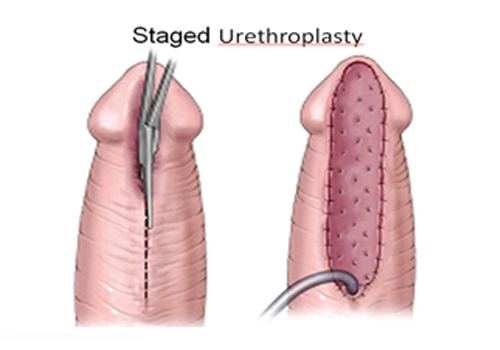
Viu and Anastomotic Urethroplasty
VIU (Visual Internal Urethrotomy) and Anastomotic Urethroplasty are two surgical approaches to treat urethral strictures. These conditions involve narrowing of the urethra, leading to obstructed urine flow and associated complications such as difficulty urinating, infections, and urinary retention. The choice of procedure depends on the stricture's location, length, and severity.
1. Visual Internal Urethrotomy (VIU)
VIU is a minimally invasive endoscopic procedure to treat short urethral strictures.
Indications
- Short strictures (<1.5 cm).
- Non-recurrent strictures.
- Strictures located in the bulbar or penile urethra.
Procedure
- Anesthesia:
- Typically performed under spinal or general anesthesia.
- Endoscopic Access:
- A cystoscope or urethroscope is inserted into the urethra.
- Incision:
- A specialized blade (cold knife) or laser is used to make an incision at the stricture site to widen the narrowed segment.
- Completion:
- A catheter is placed for a few days to promote healing and prevent re-narrowing.
Advantages
- Minimally invasive.
- Short hospital stay (day-care procedure).
- Quick recovery.
Disadvantages
- High recurrence rate (30–60%), especially for long or recurrent strictures.
- Not suitable for complex or long strictures.
2. Anastomotic Urethroplasty
Anastomotic urethroplasty is an open surgical procedure that removes the narrowed segment of the urethra and directly reconnects the healthy ends.
Indications
- Short strictures (<2.5 cm) in the bulbar urethra.
- Recurrent strictures after failed VIU.
- Traumatic urethral injuries.
Procedure
- Anesthesia:
- Performed under general anesthesia.
- Incision:
- A perineal incision is made to expose the urethra.
- Excision and Repair:
- The stricture is completely excised.
- The two healthy ends of the urethra are sutured together (end-to-end anastomosis).
- Catheter Placement:
- A catheter is left in place for 10–14 days to support healing.
Advantages
- High success rate (90–95%).
- Permanent solution for short, simple strictures.
Disadvantages
- Requires open surgery, leading to a longer recovery time.
- Not suitable for long or complex strictures.
- Risk of complications such as erectile dysfunction (rare) or incontinence.
Comparison of VIU and Anastomotic Urethroplasty
| Feature | VIU | Anastomotic Urethroplasty |
|---|---|---|
| Procedure Type | Minimally invasive | Open surgery |
| Indications | Short, simple strictures | Short, recurrent strictures |
| Success Rate | 40–70% | 90–95% |
| Recurrence | High | Low |
| Recovery Time | 1–2 weeks | 4–6 weeks |
| Hospital Stay | Outpatient or 1 day | 1–3 days |
| Anesthesia | Spinal or general | General |
| Suitability | First-line treatment | For recurrent or traumatic cases |
Postoperative Care
-
For VIU:
- Catheter removal within 3–5 days.
- Regular uroflowmetry to monitor urine flow.
- Periodic endoscopic evaluation for recurrence.
-
For Anastomotic Urethroplasty:
- Catheter removal after 10–14 days.
- Avoid strenuous activities for 4–6 weeks.
- Follow-up imaging (retrograde urethrogram) to confirm proper healing.
Potential Risks and Complications
-
VIU:
- Stricture recurrence.
- Urinary tract infections.
- Bleeding or pain during urination.
-
Anastomotic Urethroplasty:
- Erectile dysfunction (rare, <5%).
- Urethral fistula or leakage.
- Infection or delayed healing.
Which Procedure to Choose?
- VIU: Suitable for initial management of short, uncomplicated strictures.
- Anastomotic Urethroplasty: Preferred for recurrent, traumatic, or short strictures that fail to respond to VIU.
A urologist will decide the appropriate procedure based on imaging studies (e.g., retrograde urethrogram, urethroscopy) and patient-specific factors.

